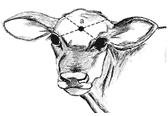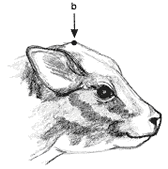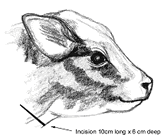Humane killing of unwanted calves
If you are a beef or dairy producer, you may be required to humanely kill calves. Calves with health problems, that have little or no commercial value or from farms in areas that do not have access to suitable markets, may be humanely killed.
You have an obligation to ensure that the killing method used is humane and performed as soon as possible after birth. Calves must be handled calmly and quietly, and not subjected to unnecessary distress, fear or pain.
There are 3 recommended methods of euthanizing calves:
- with a firearm
- with a captive-bolt pistol immediately followed by bleeding out
- lethal injection.
There is also an acceptable alternative method for premature and day-old calves.


Shooting
The most practical and humane way of killing calves is by immediately destroying the brain with a gunshot to the head.
- A .22 calibre rifle with soft nose projectiles is ideal for shooting calves.
- The preferred position is shown in positions 'a' and 'b' in the diagrams above.
- The range should be between 10cm and 25cm.
- The barrel should never be placed so it is touching the animal's head.
- Ensure the animal remains still as shooting at a moving animal is extremely hazardous to the animal and bystanders. Never fire while the animal is moving its head.
Only properly trained and licensed people should use firearms.
Captive-bolt pistol followed by bleeding out
A captive-bolt pistol fires a bolt into the skull to rapidly render the animal unconscious and allow it to be killed before regaining consciousness. Although captive-bolt pistols are not regarded as firearms, operators must be properly trained in their use.
When using a captive-bolt pistol ensure that:
- the instrument is pressed firmly against the skull before firing
- it is placed correctly to achieve a humane death
- the operator understands the animal may only be stunned and it is necessary to immediately bleed out the animal after firing
- blank cartridges are colour-coded according to the amount of charge they contain
- the manufacturer's recommendations are followed when selecting the cartridge to be used for calves
- it has been properly maintained as this is essential for it to operate correctly.
Bleeding out after rendering animal unconscious

Bleeding out should only be done when the animal has been rendered unconscious through the use of a captive-bolt or a blow to the head.
Bleeding out involves severing the major blood vessels in the neck to allow free flow of blood.
To bleed out the animal:
- Make sure you use a sharp knife and make an incision at least 10cm long and 6cm deep in the neck (as shown in the diagram above).
- Ensure both carotid arteries are cut.
- Do not under any circumstances break or sever the spinal cord. This just causes more pain and also paralysis, which adds to the potential for stress.
Lethal injection
This involves intravenously injecting the animal with a lethal dose of barbiturate or anaesthetic. This method must be carried out by either:
- a registered veterinarian
- another person who is authorised to administer that drug to the species of animal.